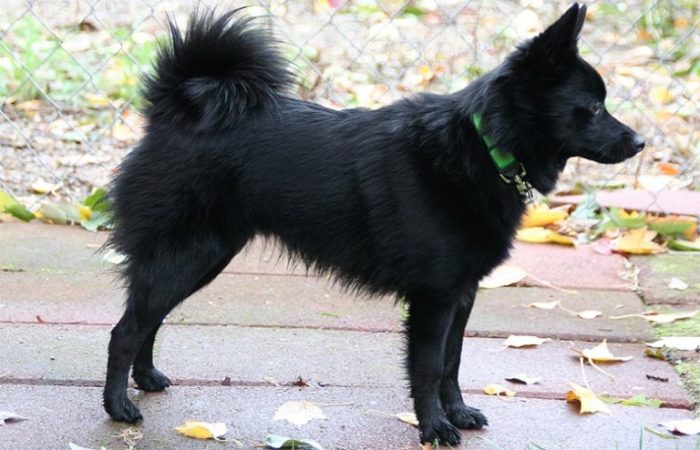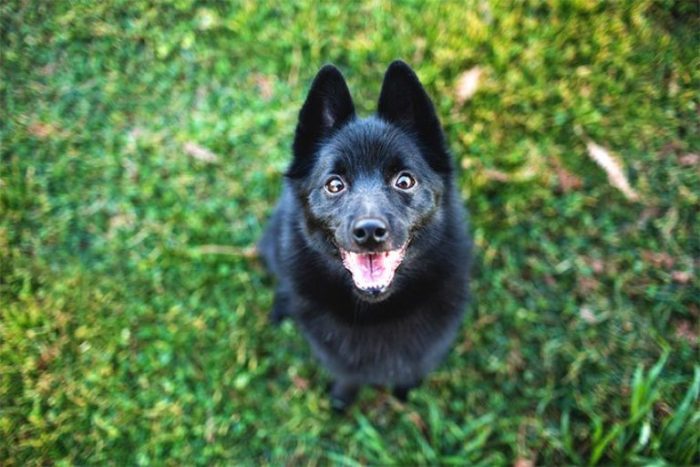If you are experienced with dogs and would love to have a canine entertainer in your household, the Schipperke breed might just be what you need. Granted, the dog is full of mischief, as well as intelligent, energetic, funny, curious, stubborn, and an escape artist. However, with the right training and socialization, you will have a best friend in the breed, turning all the negative traits into positive behaviors. Once you earn the trust of a Schipperke, it will guard and protect you to the best of its ability. But before you get one for your household, gather important details about the breed’s characteristics and other things.
Table of Contents
Origin Of The Schipperke Dog Breed
The Schipperke is an old breed from Belgium, dating back hundreds of years ago. It was first mentioned in the 1400s by a monk. In 1690, some Brussels guild workers organized a show called spits or spitske featuring the breed.
Within a short time, the breed gained popularity on the barges, earning the name Schipperke which in Flemish means “little captain” and is pronounced as “sheep-er-ker”. Often referred to as “canal boat dog,” the pup was also popular among the tradesmen.
The Schipperke attracted the attention of the wife of Leopold II, Queen Marie Henriette in 1885. The popularity of the breed grew within the upper class and before long, spread to England. The breed was imported into America by Walter J. Comstock in 1888. They founded the Schipperke Club of America in 1929.
Important Things To Know About the Schipperke

Health
The Schipperke breed is generally healthy, but they can still suffer from health issues like all things canine. Being naturally active, a Schipperke that is forced to stay without exercise may likely suffer some health problems. Again, overfeeding this furry fellow portends more harm than good, considering their small size. Excessive ingestion of food and less exercise can engender health issues in the dog’s heart, bones, teeth as well as the digestive tract.
The most common orthopedic problem that troubles the Schipperke breed is luxating patella and Legg-Perthes. Epilepsy may be evident, but it is mostly genetic, however, the MPS IIIB is one health problem that owners of the breed should take seriously. MPS IIIB is a genetic mutation affecting 15% of the entire population of the Schipperke; no other breed has had such a large number of infections. The disease targets the dog’s balance, making it difficult for it to negotiate obstacles while moving.
You will start noticing the signs from two to four years of age. For a dog that is highly active, MPS IIIB can be a real showstopper for the Schipperke. During your vet visits, always give considerations to the ophthalmologist evaluation, patella evaluation, and thyroid evaluation to ensure the good health of your furbaby.
Training
Though it is intelligent, the stubborn and humorous nature of the Schipperke can impede training. Owners shouldn’t be surprised if the dog decides to add its own touch to the exercise sessions when it’s performing in the obedience or agility ring. However, the pup is always eager to please; thus, consistency, patience, and positive reinforcement will do the trick. Early socialization with the dog is important, as it is naturally territorial even while in training.
You will have the Schipperke as your lifelong well-behaved friend if you give it agility, as well as obedience training, and always provide it with something to do. The breed likes to create its own occupation and entertainment, so owners should be warned. The dog is notorious for plotting escapes, thus it should be kept in fenced compounds; besides, the Schipperke is oblivious of road mishaps when exploring. This is why it should always be walked while leashed.
Feeding
Feeding for pups depends on several factors, age, size, metabolism, build, and activity level. All dogs shouldn’t be fed the same quantity of the food as they have their individual differences like humans. Besides, it is quite obvious that a couch potato will require less food intake than a highly active pup. The food quality also matters, in addition to nourishing your furry friend, a high-quality diet will last longer for the dog as you won’t need to shake too much into the pup’s bowl.
Pet owners should be aware of the fact that the Schipperke is prone to over-feeding and can easily fall victim to being overweight. Always measure your canine friend’s food to keep it in tip-top shape. Feeding should be done twice daily, morning, and evening as opposed to free-feeding.
Read Also: 10 Most Beautiful Dog Breeds In The World
Grooming
Brushing for the breed should be done weekly and can be increased during their heavy shedding season called blowing coat; this may occur twice yearly and lasts for about a month. You can give the dog a warm bath during its heavy shedding period to loosen and remove dead hair.
The breed is known to be clean with little odor; thus, it may only need a bath when it comes into contact with stinky substances. Nail care and dental hygiene are also necessary. Daily dental care is recommended but people who don’t have the time can do weekly cleaning to eliminate bacteria and tartar build-ups.
The click-click sound of the nails on the ground means that they are overgrown and need trimming. Begin accustoming your dog to grooming from a very young age and remember to make it a positive experience with a lot of praises and rewards.
Temperament
The Schipperke breed is always alert, confident, responsive, and curious. It retains its puppy nature of being troublesome for up to five years and does not easily give up. Thanks to its stubbornness, the dog does not easily socialize with strangers but is friendly with its own family, including children whom it is always eager to please. However, the dog has a mind of its own that it does not hesitate to follow. The canine is mischievous and stubborn but its negative traits can be calmed through early socialization and positive reinforcement during training sessions.
Does The Schipperke Make Good Family Pet?
Though they appear smart, cute, and funny, the Schipperke is not recommended for novice dog owners. But people who have an abundance of time, patience, and a great sense of humor will soon turn the breed into the best family pet that anyone can think of. If you have this dog as a companion, you may not likely experience any dull moments in your life.
Quick Facts About the Schipperke

- The Schipperke comes with a unique coat, sporting an exceptional silhouette that gives it the semblance of running from shoulder to croup. The pup is double-coated with a soft and fluffy under-coat, bathed with a stronger and lengthier outer coat.
- The pup is forever busy, always interested in everybody’s business, and randomly chasing smaller animals.
- The breed is independent, mischievous, and curious, making it one of the smartest of dog breeds.
- They often disobey commands and do what pleases them because of their rebellious nature; this makes them unsuitable for inexperienced owners.
- Over the years, this mischievous bundle of fur has earned many names, the “Tasmanian black devil”, the “little black fox”, and the “little black devil”.
- The Schipperke needs constant vigorous exercise – thanks to their curious and hyperactive nature; they should be closely supervised while on the loose.
- The pup has a sense of responsibility and loyalty, protecting and guarding its own with all the strength it can muster. This makes the owner feel safe, knowing that the guy at the gate is always at alert.
- The dog’s tongue can be completely black, but we have some that come with varying degrees of pink and patches.
- Unless trained to curb it, the Schipperke watchdog tendency turns it into a barker.
- Though they mostly come in black coats, it is not strange to see a brown, blue, or blond-coated Schipperke.
- The pup must be leashed if you live in an unfenced compound as it loves to run loose.
- The life span for the breed spreads between 13 to15 years.
